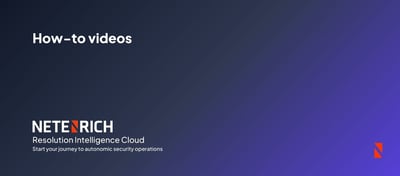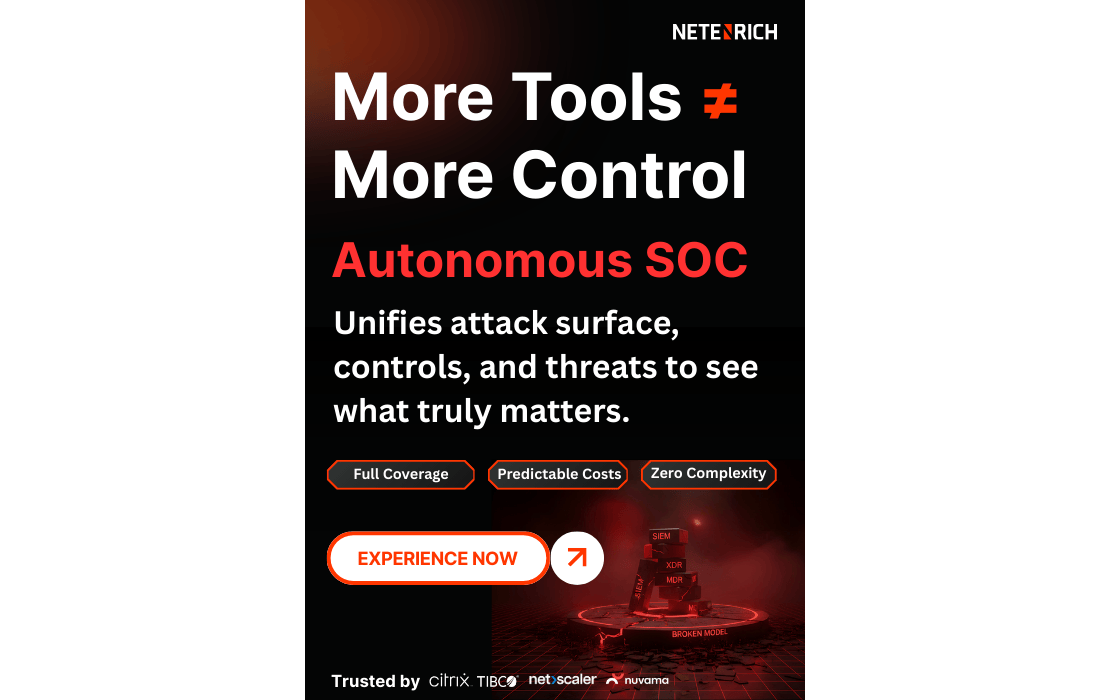Unified Risk Management: Your Big Risk Isn’t Hackers, It’s Silos.
Published on November 11, 2025 | Last updated on November 12, 2025 | 6 min read

Key Takeaways
- Unified risk management is both a paradigm shift and a must-have for strategic security leadership.
- Integration of platforms, signals, and teams is essential: misalignment is the true adversary.
- Netenrich Adaptive MDR with Google SecOps is a catalyst for sustainable, adaptive, and high-confidence risk management.
In today's digital landscape, seeing the full risk picture is no longer an advantage – it's a requirement for survival. Most enterprise security teams still rely on a tangle of legacy point solutions, legacy workflows, and disjointed reports. The result? A risk posture riddled with blind spots, slow responses, and wasted investment.
Meanwhile, the stakes have never been higher, and attackers are relentless. Organizations now face an average of 2,900+ breaches per week,2 each one faster, stealthier, and more sophisticated than the last.
In this climate, fragmented defenses won’t hold.
Enterprises need a unified risk management strategy connecting security operations, real-time analytics, and governance into a single risk picture so CISOs can cut through noise, act on business-critical threats, and give boards defensible confidence in their security posture.
Why Unified Risk Management Is the Modern Enterprise Imperative
At its core, unified risk management is about continuously connecting assets, controls, and threats in context. This enables leaders to see not just exposures, but how well defenses actually work against evolving risks. This transforms fragmented telemetry into a single, contextual picture.
Unlike rigid, compliance-driven models, unified risk management also enables proactive, predictive defense, helping leaders anticipate risk, allocate resources wisely, and communicate clearly from analyst to boardroom.
The payoff for unified cyber risk management is stark. In 2025, enterprises with automated, unified programs achieved higher risk reduction and 5% greater cost efficiency than those using fragmented approaches, with twice the alignment across security, legal, and procurement, and far faster scaling of third-party risk management.4
By contrast, enterprises still relying on fragmented tools remain exposed: vulnerabilities surged 56% year over year, flooding legacy structures and overwhelming SOCs with opportunistic and novel attacks.5
This isn't a niche problem; it's the industry standard. Our 2025 research shows that nearly half of all enterprises operate with no unified risk visibility at all, leaving them dangerously exposed.
.png?width=600&height=400&name=Pie%20chart%20Risk%20Visibility%20Gaps%20in%20Enterprises%20(2025).png)
Pie chart: Risk Visibility Gaps in Enterprises (2025)
© Netenrich 2025
As an attendee at the August 2024 Netenrich CISO Roundtable emphasized, “Likelihood, impact, and confidence together enable analysts to see the situation with the right context.” In other words, the promise of unification is that it converts raw (and overwhelming) telemetry into actionable business intelligence - fast enough to outpace attackers.
Revealing the Danger: Enterprise Operational Blind Spots in Action
Operational blind spots are the natural byproduct of silos. Picture an engineering team racing to deploy new features: CI/CD pipelines are spun up on deadline, and cloud environments expand by the hour. Without unified control mapping and visibility, a misconfigured container or API remains invisible to SOC teams. An attacker slips through, exploiting cloud privilege escalation or lateral movement opportunities-and the breach goes undetected for days or even weeks.
Did you Know?
72% of organizations report rising cyber risk, only 17% can inventory more than 95% of their assets1 - leaving most blind to critical exposures
That’s only one scenario. Another common blind spot emerges during M&A activity: as two IT environments merge, duplicate toolsets and access policies clash. Vulnerability scans may miss workloads migrating across platforms, leaving entire business units exposed to ransomware or insider abuse-with no single dashboard providing a comprehensive account of post-integration risk.
Or consider the overlooked risk of shadow IT: employees spinning up their own SaaS accounts, bypassing governance, and creating unsanctioned data flows. Without unified telemetry and policy enforcement, these shadow systems are black holes for compliance-prime targets for data exfiltration or service abuse.
These stories expose the four most insidious threats lurking in every enterprise:
- Disconnected Security Tools: Fragmented SIEM, SOAR, XDR, and endpoint monitors cannot piece together the real attack narrative or surface root causes before damage is done.
- Unaligned Controls: Adversaries adapt ruthlessly, but defense often remains static-especially when patch management, detection, and controls are managed on separate timelines and dashboards.
- Data Silos Across Teams: When security, IT, DevOps, and business analysts don’t unite around shared intelligence, prioritization slows, incident response stumbles, and finger pointing increases.
- Alert Fatigue and Missed Context: High volumes of undifferentiated, low-value alerts dull analysts’ attention just as the sophisticated threats arrive, making rapid, coordinated action nearly impossible.
There are countless instances from news headlines and security reports where these gaps led directly to devastating breaches-everything from IoT device takeovers in hospitals, to retail supply chain ransomware, to critical infrastructure outages resulting from one missed patch on an unmanaged device. Real risk cascades. It starts in one silo and spreads rapidly. Only a unified view allows leaders to spot these chain reactions and contain them before they impact the brand, the customer, and the bottom line.

Comparison of Decentralized Security Workflows vs. Unified Risk Management Outcomes
© Netenrich 2025
Creating a Centralized Risk Data Spine
Centralizing risk data is more than aggregating logs. It’s about architecting an adaptive, AI-powered core that ingests raw telemetry, normalizes threat, asset, and user context, and flags what matters for every stakeholder - SOC analyst or CISO alike.
A mature unified risk management program operationalizes three critical capabilities:
- Comprehensive Signal Ingestion: From endpoint logs to cloud posture data, SaaS activity to third-party integrations, all sources are centralized into a unified platform such as Netenrich Adaptive MDR services with Google SecOps. This eliminates information gaps and ensures that every relevant risk factor is under real-time review.
- Real-Time Correlation and Enrichment: Google SecOps’ native dashboards synthesize events on the fly, highlighting unusual privilege escalations, anomalous user behaviors, or weak controls as they form – not hours or days later.
- Automated Prioritization: AI and machine learning models sort “signal from noise,” letting teams know what is urgent, new, or indicative of advanced attack sequences. Automation also absorbs repetitive detection and correlation, i.e., the “knowns.”, significantly freeing analysts to investigate emerging risks and novel threats.
With everything routed through unified risk logic, asset inventories and network topologies are always current. Internal audit evidence and compliance scorecards are generated on demand, not hours before a regulator arrives. Most importantly, incident handoffs happen in real time, equipped with contextual notes and prioritized risk tags.
Netenrich’s solutions documentation and MDR guides explain how even highly regulated sectors like financial services and healthcare accelerate security maturity using this foundation.
Turning Frameworks into Action via Unified Risk Management
Frameworks such as NIST CSF, ISO/IEC 27001, and MITRE ATT&CK are foundational for governance – but real-world risk management demands they become part of continuous operations, not just one-time exercises. Unified platforms are designed precisely for this: mapping controls and business logic simultaneously to all relevant standards, making compliance fast, continuous, and built into daily defense workflows.
| Framework | Purpose | Key Benefit |
|---|---|---|
| NIST CSF | Security controls | US best practice, adaptability |
| ISO/IEC 27001 | Information Security Mgmt | Global compliance |
| MITRE ATT&CK | Threat Mapping | TTP correlation and defense |
Standard Frameworks and Benefits
© Netenrich 2025
Instead of “report-generating factories,” a unified risk approach like Netenrich Adaptive MDR with Google SecOps lets teams see, in real time, where controls map to regulatory requirements, where gaps exist, and how incidents or near-misses impact compliance posture. Audit-ready reporting and board communication are simplified: defendable, always accurate, and mapped to real business outcomes.
As Google and Netenrich practitioners emphasize, “Unified risk management workflows transform compliance from paperwork into proactive readiness – making risk reduction and regulatory trust simultaneous outcomes, not competing priorities.”
SecOps Integration: Security, Operations, and Business Risk Aligned
While a centralized data spine provides the technical foundation, true alignment happens when Security, Operations, and Business teams can 'speak risk in one voice'. This is where SecOps integration moves beyond technology to transform cross-team collaboration.
Securing the modern enterprise is no longer just about monitoring; it requires orchestrating every process, policy, and response to “speak risk in one voice.” Netenrich Adaptive MDR accomplished this by partnering with Google SecOps to unify SIEM, SOAR, XDR, and asset management.
Three pillars of this ecosystem drive measurable value:
- Unified Context and Visibility: Incidents and configurations are tracked and cross-correlated, providing a 360-degree view for analysts and clear accountability for remediation teams.
- Automated Adaptive Response: Google SecOps’ AI detects hidden threats, automates playbooks, and orchestrates incident handoffs in minutes - regardless of system or user location.
- Board-Ready Reporting: Real-time dashboards, mapped to MITRE ATT&CK and regulatory controls, render compliance less burdensome and board communication highly credible.

Unified MDR System
© Netenrich 2025
This unified architecture replaces endless handoffs, duplicative alerts, and fragmented root cause analysis with smooth, automated, and context-rich operations. Unlike generic unified platforms, Netenrich Adaptive MDR doesn’t just integrate dashboards, it continuously engineers alignment across assets, controls, and threats. That means reduced data ingestion, fewer false positives, and posture improvements that executives can measure.
Business Outcomes: Secure, Agile, and Accountable
Unified risk management produces more than metrics – it builds organizational resilience.
When a Fortune 1000 Netenrich client centralized its security program, SOC workload shrank as noise dropped, and key business units saw a 50% reduction in security spend paired with a twofold improvement in detection coverage and response time.3
By consolidating fragmented tools and reducing redundant ingestion, organizations can cut both wasted spend and operational friction, thereby turning tool sprawl into a unified, outcome-driven model.
But perhaps the more telling examples are in industry trends:
- In retail, unified platforms spot credential stuffing as it happens, linking point-of-sale vulnerabilities with supply chain alerts and payment processing anomalies.
- In healthcare, unified identity and access monitoring blocks insider threats before patient data is exposed.
- In the public sector, governments build unified watch floors so emerging threats are flagged as they cross jurisdictional boundaries, containing ransomware and supply chain attacks earlier than ever before.
| Outcome | Unity-Driven Result |
|---|---|
| Risk Reduction | Detect and remediate gaps before impact |
| Cost Savings | 40-50% lower operational costs |
| MTTD/MTTR | Reduction from days/hours to minutes |
| Compliance | Automated readiness, “audit in a click” |
| Board Reporting | Confidence in risk communication and action |
Unity-driven Risk Management Delivers Measurable Business Outcomes
© Netenrich 2025
Unification: The Foundation for Cyber Resilience and Modern Leadership
Unified risk management empowers CISOs and boards to finally bring clarity, trust, and strategic confidence to enterprise security. No longer forced into reactive fire drills, teams are poised to anticipate risk, innovate with assurance, and grow the business - even as threats and requirements accelerate.
Ready for true unification?
Unification is the foundation of modern security leadership. Stop managing fragmented tools and start managing business risk with confidence. It’s how you move from fighting fires to building a resilient, innovative enterprise.
See how Netenrich’s Adaptive MDR can help enterprises like yours with unified risk management you need to prevent blind spots, break silos and strengthen your security posture.
References:
- Global Cybersecurity Outlook 2025 | World Economic Forum
- CrowdStrike, Global Threat Report, 2025
- Netenrich.com October 4, 2025. Citrix and Cloud Software Group Transforms Security Operations with Netenrich Adaptive MDR
- FAIR Institute & GuidePoint Security, “2025 State of Cyber Risk Management” (June 2025)
- Chinnasamy, V. July 25, 2025. “192 Key Cybersecurity Statistics: Vulnerabilities, Exploits, and Their Impact for 2025.” INDUSFACE
Related Articles
Subscribe for updates
The best source of information for Security, Networks, Cloud, and ITOps best practices. Join us.







